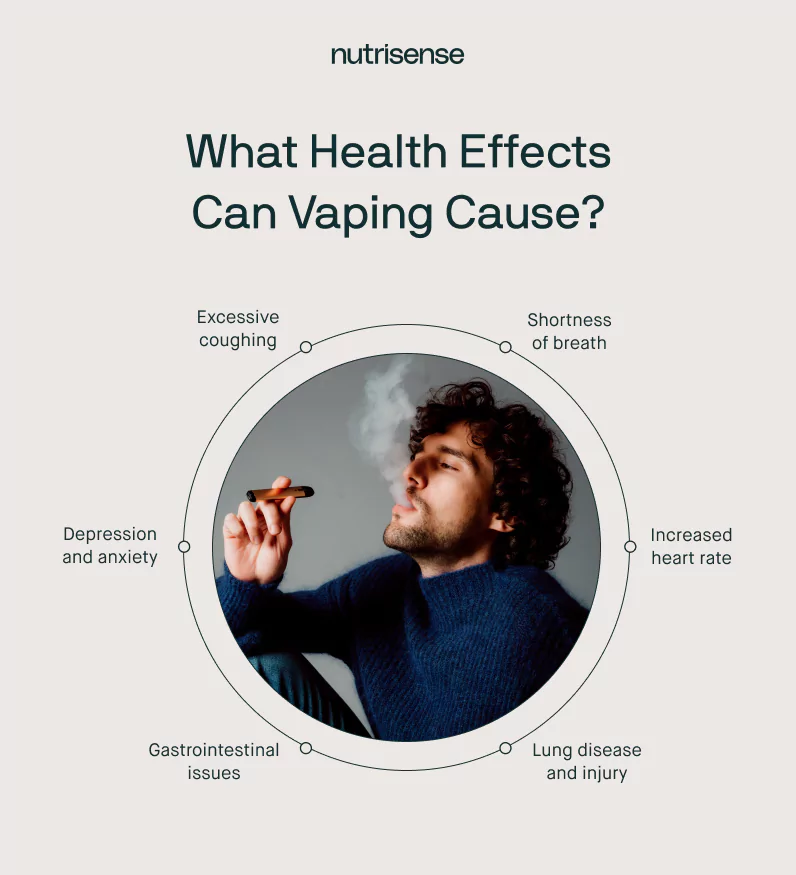Does Vaping Raise Blood Pressure?

Key Takeways
E-cigarettes, also called vapes or vape pens, are devices that produce an aerosol or vapor that typically contains nicotine, flavorings, and other chemicals.
Because they may have less negative effects than tobacco cigarettes, vapes are often used by people who smoke as a substitute for regular cigarettes. But while they seem like a promising alternative, we still have a lot to learn about the effects of e-cigarette use and how they may affect public health.
Here’s a look at the latest research in the effects of vaping on:
- Heart health and blood pressure
- Lung health
- Mental health and depression
- Gut health
What Is a Vape?
There are many kinds of vapes and they often have different names. Some vapes are disposable, while others are rechargeable and reusable, with refillable pods. Some are made to look like tobacco cigarettes or cigars, while others look like pipes or pens.
Most vapes contain a battery-powered heating element that is activated by puffing. This vaporizes the liquid (often called e-liquid or e-juice) held in a cartridge or reservoir. The user then inhales the resulting aerosol into their lungs.
This aerosol typically contains nicotine, and like other nicotine products, it may also contain other harmful substances like ultrafine particles, chemical flavorings, volatile organic compounds, cancer-causing substances, and heavy metals like nickel, tin, and lead.
They are not considered safe for youth, young adults, pregnant people, or adults who do not currently use tobacco products. Interestingly, not all vaping devices contain nicotine.
Why Are Vapes So Popular?

The use of electronic cigarettes is rapidly gaining in popularity in the United States. Research shows that 2.3 percent (more than 5.66 million) of U.S. adults currently use e-cigarettes.
Vapes and e-cigarettes are often used as a way to quit or limit cigarette smoking. However, not all e-cigarette users may be trying to quit smoking traditional cigarettes. Among vape users:
- 37.9 percent are former smokers
- 39.1 percent are current cigarette smokers
- 23.1 percent have never smoked tobacco cigarettes.
Vaping is also increasingly popular with young people. Most adult e-cig users are younger than 35 years old.
According to the FDA, about 14.1 percent (or 2.14 million) of high school students and 3.3 percent (or 380,000) of middle school students currently use e-cigarettes.
The FDA also found that:
- More than a quarter of young vapers use an e-cigarette product every day.
- Nearly 8 percent use flavored e-cigarettes, with fruit flavors being the most popular.
- Among college students, e-cigarette use in the past 30 days rose from 6 percent in 2017 to 22 percent in 2019.
Can Vaping Raise Your Blood Pressure?
Some research suggests that vaping can negatively affect blood pressure, or the force or pressure of blood pushing against the walls of your arteries. This is what carries blood from your heart to other parts of your body.
High blood pressure, also called hypertension, can increase your risk of heart disease, heart attack, and stroke. Studies show that vaping can be accompanied by a significant increase in blood pressure, which can last about 30 minutes.
Notably, other studies found that systolic blood pressure was not significantly increased after e-cigarette use. Systolic blood pressure measures how much pressure your blood is exerting against your artery walls when your heart beats.
However, diastolic blood pressure, which is how much pressure your blood is exerting against your artery walls when your heart rests between beats, appears to increase after vaping. Higher diastolic blood pressure is associated with an increased risk of cardiovascular disease, especially in women.
Studies done in animals indicate that long-term e-cigarette exposure can cause cardiac fibrosis, which poses a cardiovascular risk. According to researchers, e-cigarette use can increase arterial stiffness, even after a short exposure.
Arterial stiffness is a risk factor for high blood pressure. With these findings, anyone who regularly uses vapes may want to consult a healthcare professional for guidance.
How Harmful is Vaping?

Apart from what we know about vaping and blood pressure, how harmful is vaping? Does it come with fewer health risks than other types of smoking?
Aerosols from e-cigarettes are very different from traditional tobacco, they also contain harmful chemicals that will similarly affect both the heart and lungs.
Studies show that even five minutes of e-cigarette inhalation can negatively alter airway flow resistance in the lungs. Thirty minutes of e-cigarette inhalation, both with and without nicotine, increased the fraction of exhaled nitric oxide, or FeNO, in users’ breath.
So what does this mean? Well, increased FeNo levels are associated with inflammation and swelling in the lung airways. It was also shown to decrease vital capacity in the lungs, which is associated with weakened respiratory muscles.
Because vaping can create negative changes in the small airways of the lungs and dysregulate the lungs’ innate immunity response, it may worsen asthma and chronic obstructive pulmonary disease, or COPD.
COPD is a group of diseases, including emphysema and chronic bronchitis, that causes airflow blockage and breathing-related problems. It affects more than 16 million people in the U.S.
While these negative effects may be less harmful than those seen in conventional tobacco, research is still ongoing. More studies are needed to see how e-cigarettes affect users long-term.
Is Vaping Worse than Cigarettes?
There is some research that suggests that switching to vaping can lead to short-term improvements in cardiovascular health compared to someone who continues smoking tobacco.
For example, a 2019 study found that people who switched to e-cigarettes from tobacco experienced significant improvement in endothelial function and vascular stiffness within just one month.
When someone lights a cigarette, the tobacco and the oxygen in the air generate a combustion process. This process generates many of the toxicants, like tar and carbon monoxide, that make smoking so dangerous.
Vaping doesn’t require combustion, so no carbon monoxide or tar is produced. This isn’t to say that e-cigarettes don’t have their own harmful chemicals—vapor can contain propylene glycol, diethylene glycol, and carcinogens like formaldehyde, all of which are associated with lung damage.
While vaping may appear to be a harm reduction measure for people who already have a nicotine addiction, it’s important to remember that neither smoking nor vaping are beneficial for health for non-smokers.
According to the CDC, the negative health effects of nicotine also apply to both tobacco cigarettes and e-cigarettes. They warn that it is highly addictive, toxic to developing fetuses, and it can harm adolescent and young adult brain development.
It’s also important to remember that e-cigarettes are fairly new, and scientists are still learning about their long-term health effects.
6 Other Negative Effects of Vaping

So what other potentially negative effects of vaping are there? One notable effect is something called EVALI, or “e-cigarette or vaping product use associated lung injury.”
Here are some of the symptoms associated with EVALI, as well as other potential negative effects of vaping.
1) Coughing
Chronic coughing is a central symptom of EVALI. EVALI can also lead to respiratory bronchiolitis-associated pneumonitis, which can cause coughing and shortness of breath. Research has also shown that the nicotine in e-cigarettes can cause mucociliary dysfunction, which makes it harder to clear mucus from your airways.
This can make it harder for the lungs to defend themselves from infection and injury, and increases the risk of chronic bronchitis.
2) Shortness of Breath
Shortness of breath is another symptom of EVALI. A study from the American Thoracic Society found that e-cigarette use can cause wheezing and shortness of breath in young adults and adolescents, even in those who don’t smoke tobacco or marijuana.
3) Increased Heart Rate

Multiple studies have shown that the use of e-cigarettes with nicotine can increase heart rate. A consistently increased heart rate can cause serious health problems, including heart failure and stroke.
Vaping has also been linked to impaired blood vessel function, meaning it may have negative effects on heart health in the long term. However, more research is still needed to determine the risks.
4) Lung Disease and Injury
The use of e-cigarettes may be an independent risk factor for respiratory diseases, like chronic obstructive pulmonary disease, chronic bronchitis, or emphysema. EVALI is a serious health concern that affects some e-cigarette users.
It can cause a wide spectrum of lung injuries like damage to alveoli (tiny air sacs in the lungs), acute fibrinous pneumonia, and other lung infections.
5) Gastrointestinal Issues

EVALI has also been shown to cause gastrointestinal problems, including abdominal pain, nausea, vomiting, and diarrhea. Studies have also shown that chronic use of e-cigarettes can cause inflammation in the gut and compromise the gut barrier.
6) May Increase Depression and Anxiety
A recent 2022 study of 2,622 young adults between the ages of 18 and 25 found that higher symptoms of depression and anxiety are associated with both tobacco cigarette and e-cigarette use.
More research is needed to confirm the exact link between smoking, vaping, and mental health effects.
Does Vaping Affect Your Blood Sugar?

The effect of vaping on blood sugar is not yet fully understood. However, a 2022 study of more than 600,000 adults showed that e-cigarette use may increase the risk of prediabetes.
This finding is in line with findings that indicate that tobacco use can increase the risk of type 2 diabetes. However, more long-term controlled trials are needed to confirm the effects of vaping on glucose.
Nicotine has been shown to enhance insulin resistance by causing increased levels of cortisol and catecholamines. These are hormones that have insulin-antagonistic effects.
Early research has shown that e-cigarettes may not be directly associated with insulin resistance, but more long-term studies are needed to confirm these findings.
Find the right Nutrisense programto turn insight into progress.
Go Beyond Glucose Data with Nutrisense
Your glucose can significantly impact how your body feels and functions. That’s why stable levels are an important factor in supporting overall wellbeing. But viewing glucose isn't enough. Nutrisense, you’ll be able to learn how to use your body's data to make informed lifestyle choices that support healthy living.
One-to-one coaching
Sign up to access insurance-covered video calls to work with a glucose expert: a personal registered dietitian or certified nutritionist who will help tailor your lifestyle and diet to your goals.
Monitor and measure what matters
With the Nutrisense CGM Program, you can monitor your glucose with health tech like glucose biosensors and continuous glucose monitor (CGM)s, and analyze the trends over time with the Nutrisense App. This will help you make the most informed choices about the foods you consume and their impact on your health.
Find your best fit
Ready to take the first step? Start with our quiz to find the right Nutrisense program to help you take control.

Heather is a Registered and Licensed Dietitian Nutritionist (RDN, LDN), subject matter expert, and technical writer, with a master's degree in nutrition science from Bastyr University. She has a specialty in neuroendocrinology and has been working in the field of nutrition—including nutrition research, education, medical writing, and clinical integrative and functional nutrition—for over 15 years.


.webp)

